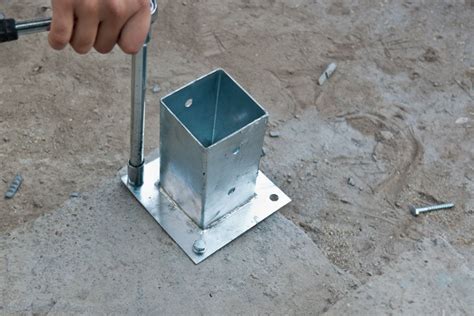How to Anchor Anything to Concrete Block: A Comprehensive Guide
Concrete blocks offer a sturdy foundation for many projects, but securely anchoring items to them requires the right approach. Whether you're mounting a mailbox, installing a fence post, or attaching a heavy piece of equipment, understanding the best anchoring techniques is crucial for safety and longevity. This guide covers various methods and considerations for anchoring different items to concrete blocks, ensuring your project is both secure and successful.
Choosing the Right Anchor: Matching the Task to the Tool
The type of anchor you choose depends heavily on the weight and size of the object you're anchoring, as well as the type of concrete block itself. Solid concrete blocks offer more anchoring options and better holding power than hollow blocks.
For lighter items: You might consider using:
- Masonry nails: These work well for relatively lightweight items, but are only suitable for solid concrete blocks. Pre-drilling a pilot hole is recommended to prevent cracking.
- Screw anchors: These offer a more secure hold than nails and are available in various sizes to suit different needs. They're also suitable for both solid and hollow blocks (though hollow blocks will require a longer screw for better grip).
- Toggle bolts: Ideal for hollow blocks, these expand behind the block's surface, providing a strong hold. They're best for medium-weight items.
For heavier items:
- Expansion anchors: These offer exceptional holding power, even in hollow blocks. They expand within the block upon tightening, providing a very secure attachment. Various types exist, such as wedge anchors and sleeve anchors, each suited for specific applications.
- Chemical anchors: These are the strongest option for heavy-duty applications. A chemical resin is injected into a drilled hole, and the anchor is inserted before the resin sets. This provides an extremely secure bond, ideal for large, heavy equipment.
How to Prepare the Concrete Block for Anchoring
Proper preparation is key to a successful anchoring project. Neglecting this step can lead to anchors failing prematurely.
- Clean the surface: Remove any dirt, dust, or debris from the concrete block's surface using a wire brush or pressure washer. This ensures proper contact between the anchor and the block.
- Locate studs (if applicable): For some applications, like mounting a shelf, finding a stud within the block's structure can provide better stability.
- Mark the location: Carefully mark the location for your anchor using a pencil or marker. This will help ensure accuracy during installation.
- Pre-drill (if necessary): Always pre-drill a pilot hole when using masonry nails or screws, and always consult the manufacturer’s instructions for recommended drill bit sizes. This minimizes the risk of cracking the concrete block.
Step-by-Step Instructions for Common Anchoring Methods
Let's explore how to use some of the most common anchoring methods:
Using Screw Anchors
- Pre-drill: Drill a pilot hole slightly smaller than the screw's diameter.
- Insert the anchor: Insert the screw anchor into the pre-drilled hole.
- Tighten the screw: Use a screwdriver or drill to tighten the screw until it's snug.
- Attach the item: Attach the item you're securing to the anchor.
Using Toggle Bolts
- Drill a hole: Drill a hole slightly larger than the toggle bolt's diameter.
- Insert the bolt: Insert the toggle bolt through the item you're anchoring.
- Push through the hole: Push the bolt through the hole in the concrete block.
- Tighten the nut: Tighten the nut on the bolt, causing the toggle wings to expand behind the block.
Using Expansion Anchors
- Drill a hole: Drill a hole that's the correct size for your specific expansion anchor (refer to manufacturer instructions).
- Insert the anchor: Insert the expansion anchor into the hole.
- Tighten the screw: Tighten the screw on the anchor, causing it to expand and grip the block.
- Attach the item: Secure your item to the anchor.
Addressing Specific Anchoring Needs
How to Anchor a Fence Post to a Concrete Block?
For fence posts, using expansion anchors or chemical anchors is recommended, especially for heavier posts. The size and type of anchor will depend on the post's weight and the block's material. Always ensure the post is plumb (vertically aligned) before securing it.
How to Anchor a Mailbox to a Concrete Block?
A robust screw anchor or a masonry nail (if the mailbox is lightweight) will usually suffice for a mailbox. Pre-drilling is crucial to prevent cracking.
What is the Best Anchor for Heavy Items on Concrete Block?
For heavy items, chemical anchors are the most secure option. Their superior holding power makes them ideal for applications where strength and stability are paramount.
Safety Precautions
Always wear safety glasses when drilling into concrete blocks to protect your eyes from debris. Use appropriate personal protective equipment (PPE) for the task, such as work gloves. If you're unsure about any aspect of the anchoring process, consult a professional.
By following these steps and choosing the right anchor for your project, you can confidently and securely attach anything to your concrete blocks, ensuring a safe and long-lasting installation. Remember to always refer to the manufacturer’s instructions for your chosen anchor for specific details and recommendations.

